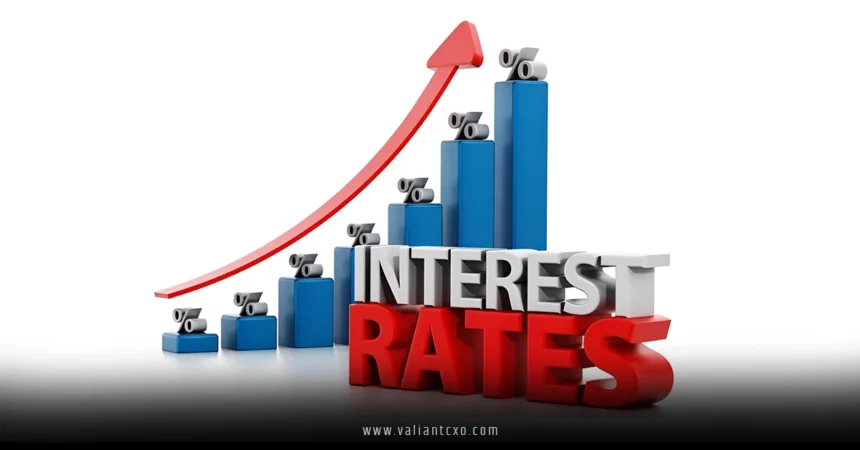How interest rates impact business growth is a question that looms large for entrepreneurs, small business owners, and corporate giants alike. Imagine your business as a ship sailing through the economic seas—interest rates are like the wind. Sometimes they propel you forward; other times, they push you off course. In this article, we’ll explore the intricate ways interest rates shape business growth, from borrowing costs to consumer spending. Whether you’re a startup founder or a seasoned CEO, understanding how interest rates impact business growth can help you navigate the choppy waters of today’s economy.
What Are Interest Rates, and Why Do They Matter?
Before diving into how interest rates impact business growth, let’s clarify what interest rates are. Simply put, they’re the cost of borrowing money, set by central banks like the Federal Reserve in the U.S. or influenced by market forces. When you take out a loan or use a credit card, the interest rate determines how much extra you’ll pay on top of the principal. For businesses, these rates are a double-edged sword, affecting everything from expansion plans to daily operations.
Why do they matter? Because money is the lifeblood of any business. Whether you’re launching a new product, hiring staff, or investing in equipment, you often need to borrow. Interest rates dictate how affordable—or expensive—that borrowing is. Let’s break down the key ways how interest rates impact business growth, so you can see the bigger picture.
How Interest Rates Impact Business Growth Through Borrowing Costs
The Cost of Capital: A Make-or-Break Factor
One of the most direct ways how interest rates impact business growth is through borrowing costs. When interest rates rise, loans become pricier. Picture trying to buy a new car with a high-interest auto loan—it stings, right? The same applies to businesses. Higher rates mean higher monthly payments on loans, which can eat into profits or force you to scale back ambitious plans.
For example, a small business looking to open a second location might need a $100,000 loan. At a 5% interest rate, the cost of borrowing is manageable. But if rates jump to 10%, those monthly payments could double, making the expansion feel like climbing a mountain with a backpack full of rocks. This is why understanding how interest rates impact business growth is critical for strategic planning.
Access to Credit: The Gatekeeper of Growth
It’s not just about cost—higher interest rates can also limit access to credit. Banks tighten their lending standards when rates climb, making it harder for businesses, especially startups, to secure loans. Without access to capital, growth stalls. You might have a killer business idea, but if you can’t get funding, it’s like having a sports car with no gas. This restricted access is a key way how interest rates impact business growth, particularly for smaller enterprises.
The Ripple Effect on Consumer Spending
When Wallets Tighten, Businesses Feel the Pinch
How interest rates impact business growth isn’t just about what happens inside your company—it’s also about your customers. Higher interest rates often mean consumers pay more for mortgages, car loans, and credit card debt. When their budgets get squeezed, they spend less on non-essentials. If you run a retail store or a restaurant, this can translate to fewer customers walking through your door.
Think of consumer spending as a river feeding your business. When interest rates rise, that river can slow to a trickle. Businesses that rely on discretionary spending—like luxury goods or travel—feel the impact most. Understanding how interest rates impact business growth through consumer behavior helps you anticipate downturns and adjust your strategy, whether it’s offering discounts or diversifying your revenue streams.
The Flip Side: Low Rates and Spending Sprees
Conversely, when interest rates drop, consumers have more disposable income. Low rates make borrowing cheaper, so people are more likely to splurge on big-ticket items like cars, homes, or even your company’s products. This boost in demand can fuel business growth, allowing you to ramp up production or expand your offerings. It’s like a tailwind pushing your business forward—another clear example of how interest rates impact business growth.
Investment Decisions and Economic Confidence
High Rates: A Pause on Big Bets
Interest rates also shape how businesses approach investments. When rates are high, the cost of financing new projects—like building a factory or upgrading technology—skyrockets. Companies often hit the pause button on these investments, opting to conserve cash instead. This hesitation can slow growth, as businesses miss out on opportunities to innovate or scale.
Imagine you’re a tech startup planning to develop a new app. High interest rates might force you to delay hiring developers or purchasing software, stunting your growth. This cautious approach is a direct result of how interest rates impact business growth by influencing investment decisions.
Low Rates: Fueling Bold Moves
On the flip side, low interest rates can spark a wave of investment. Cheap borrowing encourages businesses to take risks, like launching new products or entering new markets. It’s like getting a green light to chase your big ideas. This environment fosters innovation and expansion, showing yet another way how interest rates impact business growth.
The Impact on Cash Flow and Profit Margins
Squeezing the Bottom Line
Cash flow is the heartbeat of any business, and interest rates can either keep it steady or throw it out of rhythm. For companies with existing debt, rising rates mean higher interest payments, which can erode profit margins. If you’re already operating on thin margins, this added pressure can feel like trying to run a marathon with weights strapped to your legs.
For instance, a manufacturing business with a variable-rate loan might see its interest payments double when rates rise. That’s money that could’ve been reinvested into hiring or marketing. By understanding how interest rates impact business growth through cash flow, you can better plan for these financial challenges.
Low Rates: A Cash Flow Boost
When rates are low, businesses with debt breathe a sigh of relief. Lower interest payments free up cash for reinvestment, whether it’s upgrading equipment or boosting marketing efforts. This extra wiggle room can accelerate growth, allowing you to seize opportunities that might otherwise be out of reach. It’s another clear example of how interest rates impact business growth in a positive way.
Sector-Specific Impacts of Interest Rates
Real Estate and Construction: A Rollercoaster Ride
Some industries feel the sting of interest rate changes more than others. Real estate and construction, for example, are highly sensitive to how interest rates impact business growth. Higher rates increase mortgage costs, reducing demand for new homes and commercial properties. Construction companies may see fewer projects, stalling their growth.
Conversely, low rates can spark a building boom. Developers take advantage of cheap financing to launch new projects, and homebuyers flood the market. This surge in activity highlights how interest rates impact business growth in specific sectors.
Retail and Hospitality: Riding the Consumer Wave
Retail and hospitality businesses also face unique challenges. As mentioned earlier, high interest rates curb consumer spending, hitting these sectors hard. A coffee shop might see fewer customers splurging on lattes, while a boutique could struggle to move inventory. Understanding how interest rates impact business growth in these industries can help owners pivot, perhaps by focusing on loyalty programs or cost-cutting measures.
Strategies to Navigate Interest Rate Fluctuations
Locking in Fixed Rates
One way to shield your business from the volatility of interest rates is to lock in fixed-rate loans. This strategy ensures your borrowing costs stay predictable, even if rates rise. It’s like buying an umbrella before the storm hits—smart planning to protect your growth.
Diversifying Revenue Streams
Another tactic is to diversify your revenue streams. If your business relies heavily on consumer spending, consider offering products or services that are less sensitive to economic swings. For example, a restaurant might add catering services to offset slower dine-in traffic. This flexibility helps mitigate how interest rates impact business growth.
Monitoring Economic Indicators
Staying informed about economic trends, like those reported by Investopedia, can give you a heads-up on potential rate changes. By keeping an eye on central bank announcements or inflation data, you can make proactive decisions, such as delaying a loan or accelerating an expansion. Knowledge is power when navigating how interest rates impact business growth.
The Global Perspective: Interest Rates and International Trade
Currency Fluctuations and Export Costs
How interest rates impact business growth isn’t limited to domestic markets. Higher rates can strengthen a country’s currency, making exports more expensive and less competitive. If you’re a manufacturer selling goods overseas, this can shrink your market share. On the flip side, lower rates might weaken the currency, giving exporters a boost. This global dynamic is another layer of how interest rates impact business growth.
Supply Chain Challenges
Interest rates also affect global supply chains. Higher rates can increase the cost of importing raw materials, squeezing margins for businesses reliant on international suppliers. By understanding how interest rates impact business growth on a global scale, you can explore local sourcing or negotiate better supplier terms to stay competitive.
Conclusion: Mastering the Interest Rate Game
In the grand scheme of things, how interest rates impact business growth is a complex but crucial puzzle to solve. From borrowing costs to consumer spending, investment decisions to cash flow, interest rates touch nearly every aspect of your business. By staying informed, diversifying revenue, and planning strategically, you can turn these economic winds to your advantage. Whether rates are rising or falling, understanding their impact empowers you to steer your business toward sustainable growth. So, take charge, keep learning, and don’t let interest rates catch you off guard—your business’s future depends on it!
FAQs
1. How do rising interest rates affect small businesses specifically?
Rising interest rates increase borrowing costs, making loans for expansion or operations more expensive. Small businesses, often with tighter budgets, may struggle to access credit, slowing growth. This is a key way how interest rates impact business growth for smaller enterprises.
2. Can low interest rates guarantee business growth?
While low interest rates create favorable conditions by reducing borrowing costs and boosting consumer spending, they don’t guarantee growth. Factors like market demand and competition also play a role in how interest rates impact business growth.
3. How can businesses prepare for interest rate hikes?
Businesses can lock in fixed-rate loans, diversify revenue streams, and monitor economic indicators to prepare for rate hikes. These steps help mitigate the challenges of how interest rates impact business growth.
4. Why do some industries feel interest rate changes more than others?
Industries like real estate and retail are more sensitive to how interest rates impact business growth because they rely heavily on consumer spending and financing. Higher rates reduce demand, while lower rates can spark growth.
5. Where can I learn more about interest rate trends?
To stay informed on how interest rates impact business growth, check trusted sources like the U.S. Small Business Administration for economic insights and resources tailored to businesses.
Read Also:valiantcxo.com


